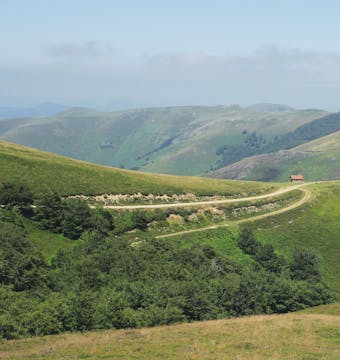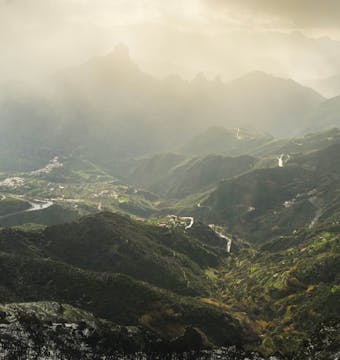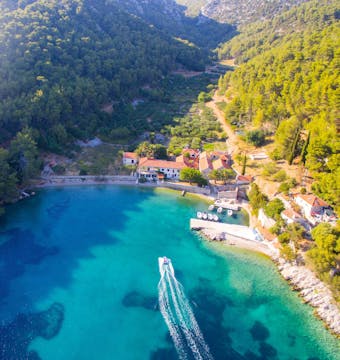
Spain Walking Tours
Exploring Spain on foot. From Majorca to Andalucía and much more!
Popular tours
- Save22%
 View Tour
View TourTrekking in Spain - Picos de Europa - 8 Days
- Bilbao to Bilbao
- Age group: 16 - 79
- Max group size: 16
Was:£1,095From£854 - Save2%
 View Tour
View TourSpain: Cultural Traditions & Hiking the Caminito del Rey - 10 Days
- Seville to Seville
- Age group: 18 - 100
- Max group size: 16
Was:£4,099From£3,997 - Save22%
 View Tour
View TourNorth Spain Discovery - 8 Days
- Barcelona to Madrid
- Age group: 15 - 99
- Max group size: 12
Was:£1,600From£1,242 - Save32%
 View Tour
View TourPremium Spain - 11 Days
- Madrid to Barcelona
- Age group: 15 - 99
- Max group size: 12
Was:£4,560From£3,096 - Save22%
 View Tour
View TourWalks and Wine Tasting in Spain and Portugal - 12 Days
- Madrid to Porto
- Age group: 16 - 79
- Max group size: 16
Was:£2,295From£1,790 - Save13%
 View Tour
View TourPortuguese Camino - 10 Days
- Porto to Santiago de Compostela
- Age group: 15 - 99
- Max group size: 12
Was:£1,695From£1,480
Spain Walking Tours
Embark on an unforgettable adventure through Spain's breathtaking landscapes, where every step leads you closer to the country's hidden treasures. Spain, with its rich history, diverse cultures, and stunning natural beauty, is a paradise for avid walkers and explorers. If you're seeking an immersive experience that combines the thrill of discovery with the joy of walking, our guided multiday walking tours in Spain are tailor-made for you.
Imagine traversing ancient pilgrimage routes, meandering through picturesque villages, and relishing in the tranquility of unspoiled countryside. From the snow-capped peaks of the Pyrenees to the sun-kissed shores of the Mediterranean, our Spain walking tours offer a captivating tapestry of landscapes that will leave you spellbound.
Our meticulously designed itineraries take you off the beaten path, unveiling Spain's best-kept secrets. Led by experienced guides who are passionate about their country's heritage, you'll dive into local stories, legends, and traditions that breathe life into every step you take. Immerse yourself in the vibrant culture, savor authentic cuisine, and connect with the warm-hearted locals who will welcome you with open arms.
Whether you're a seasoned hiker or simply love to explore at a leisurely pace, our walking tours in Spain cater to all levels of fitness and interests. Choose from a variety of options that suit your preferences, including the legendary Camino de Santiago, a soul-stirring journey that has attracted pilgrims for centuries. Traverse the rugged landscapes of the Picos de Europa National Park, lose yourself in the verdant beauty of the Andalusian countryside, or wander along the idyllic coastal paths of the Costa Brava.
At The Adventure People, we understand the importance of a seamless and worry-free travel experience. We take care of all the logistics, ensuring comfortable accommodations, reliable transportation, and knowledgeable guides who will lead you through the enchanting routes. All you need to do is lace up your walking shoes, embrace the spirit of adventure, and allow yourself to be captivated by the wonders that Spain has to offer.
Unleash your wanderlust and join us on a walking tour that will awaken your senses, invigorate your spirit, and create lasting memories. Discover the hidden gems, immerse yourself in the rich tapestry of Spanish culture, and forge connections that will leave an indelible mark on your soul. Get ready to embark on an extraordinary journey through Spain's captivating landscapes and experience the magic of walking in one of the world's most remarkable destinations.
Book your Spain walking tour today and let your footsteps lead you to the heart and soul of this extraordinary country.
What are the most popular walking tours in Spain?
Spain offers a plethora of multiday guided walking tours that cater to various interests and preferences. Among the numerous options available, there are a few standout tours that have gained popularity and captured the imagination of adventurers from around the world. Here are some of the most sought-after multiday guided walking tours in Spain:
Camino de Santiago: Undoubtedly one of the most famous walking routes in the world, the Camino de Santiago draws thousands of pilgrims each year. This ancient pilgrimage trail, also known as the Way of St. James, spans across several routes that converge in Santiago de Compostela. The most renowned route, the Camino Frances, offers a transformative journey through diverse landscapes, charming villages, and historic sites, culminating in the majestic Santiago de Compostela Cathedral.
Picos de Europa National Park: Nestled in northern Spain, the Picos de Europa National Park boasts awe-inspiring mountain scenery, verdant valleys, and cascading rivers. Guided walking tours in this region allow you to explore its rugged beauty while traversing well-marked trails. Experience the thrill of hiking amidst towering peaks, discover quaint mountain villages, and encounter diverse wildlife, including chamois and golden eagles.
Andalusian White Villages: Immerse yourself in the idyllic charm of Andalusia's White Villages (Pueblos Blancos) on a guided walking tour. This enchanting region, characterized by its whitewashed houses perched on hillsides, offers a captivating blend of natural beauty and rich cultural heritage. Wander through olive groves, fragrant orange orchards, and narrow cobbled streets as you explore picturesque villages like Ronda, Grazalema, and Arcos de la Frontera.
Costa Brava Coastal Path: For those seeking a coastal adventure, the Costa Brava in Catalonia provides an idyllic setting for a multiday walking tour. The rugged coastline, dotted with hidden coves, pristine beaches, and charming fishing villages, offers breathtaking vistas at every turn. Traverse the well-maintained coastal path, enjoying panoramic views of the Mediterranean Sea and exploring charming towns like Cadaqués, Begur, and Tossa de Mar.
Basque Country: Discover the unique beauty and culture of the Basque Country on a guided walking tour. This region, located in northern Spain and southern France, boasts a dramatic coastline, lush green valleys, and charming fishing ports. Walk along the stunning coastal paths, visit traditional Basque villages, and indulge in the renowned gastronomy that has earned the region a reputation as a food lover's paradise.
These popular multiday guided walking tours in Spain offer an array of captivating experiences, from spiritual journeys to mountain adventures and coastal explorations. Whichever tour you choose, you can expect to be immersed in Spain's natural wonders, cultural heritage, and warm hospitality, making for an unforgettable walking adventure.
What is the best time to go on a walking tour in Spain?
The best time to go on a walking tour in Spain largely depends on the region you plan to explore and your personal preferences regarding weather and crowd levels. Spain's diverse geography and climate offer different experiences throughout the year. Here's a breakdown of the seasons and the optimal times to embark on a walking tour in Spain:
Spring (March to May): Spring is an excellent time for walking tours in most parts of Spain. The weather tends to be mild and pleasant, with blossoming flowers and vibrant landscapes. Regions like Andalusia, Catalonia, and the Camino de Santiago are particularly delightful during this time, offering comfortable temperatures for walking and fewer crowds compared to the peak summer season.
Summer (June to August): Summer can be a popular time to visit Spain, especially coastal areas and popular tourist destinations. While the weather is generally warm and sunny, it can get hot, particularly in southern regions like Andalusia and parts of central Spain. Coastal areas and higher altitudes, such as the Pyrenees or Picos de Europa, provide relief from the heat. If you choose to walk during summer, it's advisable to plan your routes in the early morning or late afternoon to avoid the hottest hours of the day.
Autumn (September to November): Autumn is another fantastic time to embark on a walking tour in Spain. The weather remains pleasant, with cooler temperatures and milder conditions. The countryside comes alive with autumn colors, making it a picturesque time to explore regions like Galicia, Basque Country, and the Pyrenees. The crowds tend to diminish during this season, allowing for a more serene and immersive experience.
Winter (December to February): Winter can be a great time for walking tours in certain regions of Spain, particularly in the southern part of the country. Andalusia, with its mild winters and sunny days, offers an appealing option for walkers seeking a respite from colder climates. The Canary Islands also provide a year-round mild climate, making them an attractive destination for winter walks.
It's important to note that weather patterns can vary across regions, and it's advisable to check specific conditions and trail accessibility before planning your walking tour. Additionally, popular routes like the Camino de Santiago may experience higher pilgrim traffic during peak summer months, while other regions may be quieter during this time.
Ultimately, the best time to go on a walking tour in Spain depends on your preferences, the specific region you wish to explore, and the type of experience you seek. Consulting with local experts, tour operators, or researching specific routes will help you determine the ideal time for your walking adventure in Spain.
Do I need a visa to visit Spain?
Visa requirements for visiting Spain depend on your nationality and the purpose and duration of your visit. Here are some general guidelines:
Schengen Area: Spain is a member of the Schengen Area, which allows for visa-free travel between member countries for certain nationalities. If you are a citizen of a Schengen member country or a national of a visa-exempt country (such as the United States, Canada, Australia, or the United Kingdom), you can generally enter Spain for tourism or business purposes for up to 90 days within a 180-day period without needing a visa. However, it's important to ensure that your passport is valid for at least six months beyond your planned departure date.
Non-Schengen and Visa-Required Nationals: If you are a citizen of a country that is not part of the Schengen Area and does not have a visa exemption agreement with Spain, you will likely need to apply for a Schengen visa before your trip. This applies to nationals of countries such as India, China, Russia, and many others. You should contact the Spanish embassy or consulate in your country to inquire about the specific visa requirements and procedures.
It's important to note that visa requirements can change, and it's recommended to check with the appropriate authorities, such as the Spanish embassy or consulate in your country, or consult official government websites for the most up-to-date and accurate information regarding visa requirements for your nationality.
Additionally, please keep in mind that while a visa may allow you to enter Spain, you may still need to comply with certain entry requirements, such as having a valid return ticket, proof of sufficient funds for your stay, and travel insurance. It's advisable to review all entry requirements and documentation needed well in advance of your planned trip to Spain.
How fit do I need to be to enjoy a walking tour in Spain?
The level of fitness required to enjoy a walking tour in Spain can vary depending on the specific tour and its difficulty level. Spain offers a wide range of walking tours, from leisurely strolls through picturesque villages to more challenging hikes in mountainous terrain. Here are a few factors to consider:
Walking Tour Difficulty: Different walking tours have different difficulty levels, and it's essential to choose one that matches your fitness level and hiking experience. Some tours are designed for beginners or those who prefer a more relaxed pace, with shorter distances and easier terrain. Other tours, such as those in mountainous regions or long-distance trails like the Camino de Santiago, may require a higher level of fitness and endurance.
Terrain and Elevation: The type of terrain you'll encounter on the walking tour is an important consideration. Walking on flat or gently rolling terrain is generally less physically demanding compared to hiking steep inclines or uneven trails. Mountainous regions like the Pyrenees or Picos de Europa will involve more challenging elevation changes and require a higher level of fitness and stamina.
Duration and Daily Distances: The duration of the walking tour and the daily distances covered can impact the level of fitness required. Longer tours or those with more extensive daily distances may demand greater endurance and stamina. It's important to assess your ability to sustain physical activity over multiple days and gradually build up your fitness level if necessary.
Personal Fitness and Health: Your overall health and fitness level should be taken into account. If you have any pre-existing medical conditions or concerns, it's advisable to consult with your healthcare provider before embarking on a walking tour. They can provide guidance on your physical capabilities and offer recommendations for preparation and precautions.
Regardless of the specific walking tour you choose, it's generally beneficial to engage in regular physical activity leading up to your trip to improve your stamina and endurance. This can include walking, hiking, or other cardiovascular exercises that help condition your muscles and prepare you for the demands of the tour.
It's worth noting that many walking tour operators offer a range of tours with varying difficulty levels, allowing you to find one that matches your fitness and comfort level. It's recommended to read tour descriptions, speak with tour operators, and assess your own fitness level honestly to select a walking tour that you'll enjoy and feel comfortable with.
What is the currency of Spain and how can I access my money?
The official currency of Spain is the Euro (€). When traveling to Spain, it's advisable to have some euros with you for immediate expenses upon arrival. Here are some ways to access your money while in Spain:
Cash: Carrying some cash in euros is always useful, especially for smaller establishments that may not accept credit cards. You can exchange currency at banks, exchange offices (known as "casas de cambio"), or at the airport. It's recommended to compare exchange rates and fees to get the best deal. ATMs are also widely available, allowing you to withdraw euros using your debit card. Keep in mind that your bank may charge fees for international withdrawals, so it's advisable to check with your bank before your trip.
Credit and Debit Cards: Credit and debit cards are widely accepted in most establishments throughout Spain, including hotels, restaurants, shops, and attractions. Visa and Mastercard are the most commonly accepted card networks, followed by American Express and Diners Club, although acceptance may vary depending on the location. Make sure to notify your bank or card issuer about your travel plans to avoid any potential issues with card usage.
Travel Money Cards: Another option is to use a travel money card, also known as a prepaid currency card. These cards allow you to load multiple currencies onto a single card, including euros. Travel money cards are convenient, and you can use them like a regular debit card for purchases or ATM withdrawals. They often offer competitive exchange rates and can be topped up online or through mobile apps.
Mobile Payments: Spain has embraced mobile payment methods, such as Apple Pay, Google Pay, and Samsung Pay. If your mobile device is enabled for contactless payments and your card issuer supports these services, you can use your phone or smartwatch to make payments at compatible payment terminals.
Regardless of the method you choose, it's advisable to keep your money and valuables secure while traveling. Consider using a money belt or a secure wallet to protect your cash and cards from theft or loss.
When accessing money in Spain, be mindful of potential fees, exchange rates, and withdrawal limits set by your bank or card issuer. It's a good idea to inform yourself about these details before your trip and consider carrying a mix of payment methods to ensure flexibility and convenience throughout your journey.
Is my luggage transported for me during the tour?
The transportation of luggage during a walking tour in Spain can vary depending on the specific tour operator and itinerary. Here are a few scenarios commonly found in walking tours:
Self-Guided Tours: In self-guided tours, where you navigate the route independently, it is common for participants to carry their own luggage. You would typically pack your belongings into a backpack or suitcase and carry it with you throughout the tour. It's important to choose luggage that is comfortable and suitable for walking, taking into account the weight and size restrictions set by the tour operator.
Guided Tours with Vehicle Support: Some guided walking tours may include vehicle support, where a support van or vehicle transports your luggage from one accommodation to the next. This allows you to enjoy the walk without the burden of carrying your belongings. You would typically pack your luggage in the morning, leave it with the support vehicle, and find it waiting for you at your next accommodation.
Portage Services: In certain walking tours, especially longer or more challenging routes like the Camino de Santiago, you may have the option to utilize portage services. Portage services involve arranging for a third-party company to transport your luggage between accommodations along the route, allowing you to walk with a lighter daypack. This service can be convenient for those who prefer not to carry their luggage during the walk.
It's important to carefully review the details of your chosen walking tour to understand the specific luggage arrangements provided. Tour operators typically provide information about luggage transportation in their tour descriptions or upon inquiry. If in doubt, contacting the tour operator directly will ensure clarity regarding luggage logistics.
Regardless of the luggage arrangements, it's recommended to pack efficiently and keep your luggage lightweight, especially if you will be carrying it yourself. This allows for greater comfort and ease during the walking tour. Additionally, having a daypack for essentials like water, snacks, a camera, and rain gear is generally advisable, regardless of the luggage transportation arrangements.
What should I pack for my walking tour in Spain?
When packing for a walking tour in Spain, it's essential to strike a balance between comfort, functionality, and packing light. Here's a suggested packing list to help you prepare for your walking adventure:
- Clothing:
- Comfortable walking shoes or hiking boots with good traction
- Lightweight and moisture-wicking socks
- Quick-drying and breathable pants or hiking trousers
- Lightweight, long-sleeved shirts for sun protection
- T-shirts or tops for layering
- Fleece or lightweight jacket for cooler evenings or higher altitudes
- Waterproof or windproof outer layer
- Hat or cap for sun protection
- Swimwear (if your tour includes coastal areas or swimming opportunities)
- Gear and Accessories:
- Backpack or daypack for carrying essentials during the walks
- Water bottle or hydration bladder
- Sunscreen with a high SPF and lip balm
- Insect repellent
- Sunglasses
- Travel towel (quick-drying and compact)
- Walking poles (if preferred)
- Portable charger or power bank for electronics
- Universal power adapter (if needed)
- Camera or smartphone for capturing memories
- Small first aid kit with essentials like band-aids, pain relievers, blister treatments, etc.
- Other Essentials:
- Valid passport and necessary travel documents
- Money, including some cash in euros and cards for payments
- Travel insurance details
- Prescription medications (if applicable)
- Personal toiletries in travel-sized containers
- Lightweight and quick-drying travel clothing (optional for washing on the go)
- Travel-sized laundry detergent (optional for washing clothing)
- Earplugs and eye mask for better sleep
It's important to consider the specific details of your walking tour, such as the duration, expected weather conditions, and any specific requirements or recommendations provided by the tour operator. This will help you tailor your packing list accordingly.
Remember to pack only essential items to keep your luggage light and manageable during the walking tour. Consider layering your clothing for versatility and be prepared to do laundry or wash clothing if necessary during the tour.
Lastly, be mindful of any weight or size restrictions imposed by airlines or transportation providers if you'll be flying to or within Spain. Checking their guidelines and requirements in advance will help ensure a smooth journey.
Is WIFI available on the walking tours?
The availability of Wi-Fi on walking tours in Spain can vary depending on the specific tour operator and the locations visited. Here are a few possibilities:
Accommodations: Most accommodations, such as hotels, guesthouses, and hostels, in popular tourist areas or towns along walking routes, typically offer Wi-Fi access to their guests. However, the quality and speed of the connection may vary, particularly in more remote or rural locations.
Restaurants and Cafes: Many restaurants, cafes, and bars in Spain provide free Wi-Fi to their customers. During your walking tour, you may come across establishments where you can take a break, enjoy a meal, and access Wi-Fi to check emails, browse the internet, or stay connected.
Public Wi-Fi: In some towns and cities, you may find public Wi-Fi hotspots in designated areas like main squares, parks, or tourist information centers. These public Wi-Fi networks are often free to use, although they may require registration or have time limitations.
Mobile Data: If consistent and reliable internet access is essential during your walking tour, you may consider getting a local SIM card with a data plan for your smartphone. This option allows you to have internet connectivity wherever there is a mobile network signal. It's advisable to check the coverage and data plans offered by different mobile network providers in Spain.
However, it's important to note that during certain walking tours, especially those in remote or wilderness areas, the availability of Wi-Fi may be limited or even nonexistent. Some walking tours prioritize disconnecting from technology and immersing oneself in nature, so it's worth checking with the tour operator regarding the specific Wi-Fi availability during the tour.
To ensure you stay connected when necessary, it's recommended to plan and prepare accordingly. Consider downloading offline maps, guidebooks, or any other useful apps or resources that can be accessed offline. Additionally, informing friends, family, or colleagues about the possibility of limited connectivity during the walking tour will help manage expectations and stay in touch appropriately.
Ultimately, the availability of Wi-Fi on walking tours in Spain will depend on the specific tour arrangements, locations visited, and the infrastructure in place. It's advisable to communicate with the tour operator or check the tour details to understand the Wi-Fi availability and plan accordingly.
Is there phone signal on the walking tours?
The availability of phone signal during walking tours in Spain can vary depending on the specific tour route and the regions visited. Here are some factors to consider:
Populated Areas: In towns, villages, and popular tourist areas along the walking tour routes, you can generally expect to have good phone signal coverage. These areas are typically equipped with cellular towers that provide network coverage from major mobile service providers.
Remote or Wilderness Areas: In more remote or wilderness areas, such as mountainous regions or nature reserves, the phone signal may be weaker or even unavailable. These areas often have limited infrastructure for cellular coverage. It's important to be prepared for potential signal blackouts during these stretches of the tour.
Network Coverage: The quality and coverage of phone signals can vary based on the mobile network provider you are using. Major providers like Movistar, Vodafone, and Orange generally offer broad coverage throughout Spain, but some rural or remote areas may have better coverage with one provider compared to others. It's advisable to check the coverage maps or consult with your mobile service provider to understand their network coverage in the specific regions you'll be visiting.
Elevation and Landscape: The topography and landscape can also affect phone signal strength. In areas with mountainous terrain or dense forests, the signal may be weaker due to obstructions or limited infrastructure. Conversely, open and flat landscapes may have better signal reception.
Emergency Services: It's worth noting that even in areas with limited or no regular phone signal, emergency services like emergency call services (112) or mountain rescue services may still be accessible. Emergency services are often prioritized to ensure safety in remote areas, but it's always advisable to have a contingency plan and carry necessary safety equipment, especially when venturing into more challenging or isolated terrains.
To stay connected and navigate potential signal limitations during the walking tour, consider the following:
- Inform your travel companions or a trusted person about your itinerary and expected check-ins.
- Carry a physical map, guidebook, or offline maps on your smartphone as a backup for navigation.
- Use messaging apps or communication tools that work offline or via Wi-Fi when available.
- Consider renting or purchasing a satellite phone if you'll be exploring extremely remote or isolated areas where regular phone signal is unlikely.
It's important to manage expectations and plan accordingly, understanding that some walking tour routes may offer limited phone signal coverage. Embrace the opportunity to disconnect and immerse yourself in the natural surroundings, but also take necessary precautions for safety and communication needs.
What accommodation should I expect on the walking tours?
The accommodation provided on walking tours in Spain can vary depending on the tour operator, the specific tour package, and the regions visited. Here are some common types of accommodation you may encounter:
Hotels: Many walking tours offer accommodation in hotels, ranging from comfortable, mid-range options to more luxurious establishments. Hotels provide amenities such as private rooms, en-suite bathrooms, and various facilities like restaurants, lounges, and sometimes even spas or swimming pools. The level of comfort and amenities can vary, so it's advisable to review the tour details or consult with the tour operator for specific information about the hotels included in your tour.
Guesthouses and Bed & Breakfasts: Some walking tours may feature smaller, family-run guesthouses or bed and breakfast establishments. These accommodations often provide a more intimate and cozy experience, with comfortable rooms and shared or private bathrooms. Guesthouses and B&Bs can offer a personal touch, and the hosts may provide local insights and recommendations.
Rural Farmhouses and Country Cottages: In rural or countryside areas, walking tours may include accommodation in traditional farmhouses, country cottages, or rural retreats. These accommodations often provide a rustic and authentic experience, allowing you to immerse yourself in the local culture and surroundings. Facilities may be more basic, but you'll likely enjoy the charm of staying in traditional accommodations.
Refugios and Albergues: If you're embarking on a walking tour that includes a portion of the Camino de Santiago or other popular pilgrimage routes, you may encounter refugios or albergues. These are budget-oriented accommodations specifically catering to pilgrims and hikers. Refugios often provide dormitory-style rooms with shared facilities, creating a communal atmosphere where walkers can meet and interact with fellow travelers.
Paradores: Paradores are unique and historic accommodations found throughout Spain. They are typically located in converted castles, monasteries, palaces, or other historic buildings. Staying in a Parador offers a blend of luxury, history, and cultural immersion, providing a truly memorable experience. However, it's important to note that not all walking tours include Paradores due to their higher price range.
It's important to review the specific tour details or consult with the tour operator to understand the type of accommodation provided in your chosen walking tour. Factors such as comfort level, amenities, and the style of accommodation can vary significantly. Additionally, keep in mind that in some remote or less-developed areas, accommodation options may be limited, and facilities may be more basic.
Preparing for the tour, pack necessary items like toiletries, comfortable clothing, and any specific items recommended by the tour operator based on the type of accommodation provided.
Remember to inform the tour operator about any specific accommodation preferences or requirements you may have, such as rooming arrangements or dietary restrictions. This will help ensure that your accommodation needs are addressed to the best extent possible during the walking tour.
What is the food like in Spain?
The food in Spain is renowned for its rich flavors, diverse regional cuisines, and emphasis on fresh, high-quality ingredients. Spanish cuisine is deeply rooted in its cultural heritage, with influences from various civilizations and regions. Here are some key aspects of the food in Spain:
Tapas and Small Plates: Tapas are an iconic part of Spanish cuisine. These small, flavorful dishes are perfect for sharing and trying a variety of flavors. From traditional favorites like patatas bravas (fried potatoes with spicy tomato sauce) and croquetas (breaded and fried croquettes) to regional specialties like jamón ibérico (cured ham) and gambas al ajillo (garlic shrimp), tapas offer a delightful culinary experience.
Seafood and Fresh Fish: Spain's extensive coastline means seafood plays a significant role in its cuisine. Coastal regions like Galicia, Catalonia, and Andalusia are known for their seafood dishes. From grilled sardines and paella with prawns to marinated anchovies and seafood stews like zarzuela, you'll find a wide array of delectable seafood options.
Paella and Rice Dishes: Paella, a rice-based dish cooked in a wide shallow pan, is one of Spain's most famous culinary exports. Originating from the Valencia region, paella is typically made with ingredients like rice, saffron, chicken, rabbit, and a variety of seafood. There are also regional variations like paella de mariscos (seafood paella) and paella mixta (mixed paella with both meat and seafood).
Jamón and Charcuterie: Spain is renowned for its cured meats, with jamón ibérico being a particular highlight. This cured ham, made from acorn-fed Iberian pigs, is prized for its rich flavor and melt-in-your-mouth texture. Charcuterie boards featuring an assortment of cured meats, such as chorizo, salchichón, and lomo, are a popular choice.
Regional Specialties: Each region of Spain has its own culinary traditions and specialties. From the hearty stews and pintxos (Basque-style tapas) of the Basque Country to the fresh seafood and gazpacho (cold tomato soup) of Andalusia, exploring the regional cuisines of Spain is a delightful adventure.
Wine and Sangria: Spain is renowned for its wines, with regions like Rioja, Ribera del Duero, and Priorat producing excellent reds. Spain is also known for its refreshing sangria, a popular wine-based drink typically made with red wine, fruit, and spices.
Sweet Treats: Spanish desserts are a treat for the sweet tooth. Indulge in delights like churros (fried dough served with thick hot chocolate), flan (caramel custard), tarta de Santiago (almond cake), and turron (nougat).
It's worth mentioning that mealtimes in Spain tend to be later compared to other countries, with lunch (la comida) typically eaten around 2-3 PM and dinner (la cena) starting around 9-10 PM. The Spanish also embrace the concept of a leisurely, social dining experience.
Overall, the food in Spain offers a wonderful combination of traditional flavors, fresh ingredients, and regional diversity. Exploring the local cuisine is a highlight of any visit to Spain, as it offers a true taste of the country's vibrant culinary culture.
Can I drink the tap water in Spain?
Yes, in most parts of Spain, tap water is considered safe to drink. The water supply in Spain generally meets high sanitary standards and is subject to regular testing and treatment. However, there can be variations in water quality and taste depending on the specific region.In cities and urban areas, tap water is typically treated and safe for consumption. Municipalities often provide information to residents and visitors confirming the drinkability of tap water. It's generally safe to drink tap water in popular tourist destinations, hotels, restaurants, and public establishments.
In more rural or remote areas, particularly in mountainous regions or small villages, some people may prefer to drink bottled water or use a water filter. In such cases, it's advisable to consult with locals or the accommodation provider for guidance on the water quality in that particular area.
If you're uncertain about the quality of tap water or have a sensitive stomach, you can always opt for bottled water, which is widely available for purchase in stores, supermarkets, and restaurants throughout Spain. Look for bottled water with the label "agua mineral" or "agua sin gas" (still water) if you prefer non-carbonated water.
It's also worth noting that Spain has a strong commitment to environmental sustainability, and tap water is encouraged as an eco-friendly choice. Refilling reusable water bottles with tap water is an environmentally conscious and cost-effective option during your walking tour.
To summarize, while tap water is generally safe to drink in Spain, it's advisable to be aware of any local variations and consider personal preferences. If you have any concerns or specific health conditions, consult with your healthcare provider or refer to the guidance provided by local authorities or your accommodation provider for the most up-to-date information on the water quality in the region you'll be visiting.
Which are the most demanding Spanish walking tours?
Spain offers a range of demanding walking tours for those seeking a challenging and rewarding hiking experience. Here are a few of the most renowned and demanding walking tours in Spain:
Camino de Santiago (The Way of St. James): The Camino de Santiago is a famous pilgrimage route that stretches across northern Spain to the city of Santiago de Compostela. The most popular route, the Camino Francés, covers approximately 800 kilometers (500 miles) and requires several weeks to complete. The terrain varies from flat stretches to hilly sections, with challenging ascents and descents along the way. This historic trail offers a profound cultural and spiritual experience.
GR 20: Located in Corsica, an island that is part of France but geographically close to Spain, the GR 20 is often considered one of the most challenging long-distance trails in Europe. It covers about 180 kilometers (112 miles) through rugged and mountainous terrain. The trail involves steep climbs, exposed sections, and demanding descents. Hikers should be well-prepared and have experience with mountain hiking and scrambling.
Picos de Europa: Situated in northern Spain, the Picos de Europa mountain range offers spectacular landscapes and challenging hiking opportunities. The region features a network of trails ranging from day hikes to multi-day routes. Hiking in the Picos de Europa can involve steep ascents, rugged terrain, and narrow paths with significant elevation changes. The rewards include breathtaking mountain vistas and the chance to explore picturesque villages.
Aneto Peak: Aneto is the highest peak in the Pyrenees mountain range and attracts experienced mountaineers and hikers. The ascent to Aneto Peak requires technical skills and mountaineering equipment, including ice axes and crampons. It's a challenging and demanding climb that should only be attempted by experienced hikers with proper training and equipment.
Sierra Nevada Traverse: The Sierra Nevada mountain range in southern Spain offers a challenging traverse route for experienced hikers and mountaineers. The traverse covers approximately 70 kilometers (43 miles) with significant elevation gain and challenging terrain. The route involves high-altitude sections, exposed ridges, and some scrambling. Hikers should have experience in mountainous environments and be well-prepared for changing weather conditions.
It's important to note that these demanding walking tours require good physical fitness, proper hiking gear, and experience in challenging terrains. Adequate preparation, including physical training, navigation skills, and knowledge of safety procedures, is essential. Additionally, some tours may require permits or guides for certain sections.
When considering a demanding walking tour, it's recommended to consult with experienced hikers, local guides, or tour operators who specialize in these routes. They can provide detailed information, guidance, and support to ensure a safe and enjoyable experience.


Spain Walking Tours Highlights
Book With Confidence
Monthly Payments
Spread the costs with no interest or additional fees
Best Price Guarantee
We won't be beaten on price. If you find this adventure at a lower price please get in touch!
Reserve now & pay later
Reserve your adventure today and pay later, free of charge
ATOL protected
Book with confidence
Hold your space today, for free
or book your trip with a deposit and then pay the rest in instalments.
Reserve your flights with us
Add flights to your booking and we'll take care of the rest. You'll get 24/7 support from our team & ATOL protection.
Speak to our experts
Call or email our expert team to find out more and help with ideas and planning.










